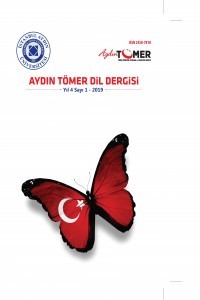Yunus Emre Divanıyla Türk Dillilere Atasözü ve Deyim Öğretimi
İnsanlar birçok farklı nedenden dolayı çoğu zaman ana dillerinin konuşulduğu ülkelerden uzaklaşmakta ve farklı ülkelerde yaşam sürmektedir. Bu durumda yaşanılan ülkeye uyum sağlayabilmek ve hayatını idame edebilmek için o ülkenin dilini kullanmak zorunda kalmaktadırlar. Bu zorunluluk beraberinde kişilerin ana dillerinden uzaklaşmalarına, ana dillerini unutmalarına ve bu dilde konuşma güçlükleri çekmelerine neden olmaktadır. Ana dile karşı yaşanan bu uzaklaşma ise kültüre yabancılaşmaya neden olmaktadır. Ana dille kültürü birleştiren temel dil yapılarından ikisi atasözü ve deyimlerdir. Türk dillilerin bu dil yapılarına yabancılaşması, ana dilde anlama ve anlatmada yetersizlikler oluşmasına neden olmaktadır. Bu nedenle Türk dillilere Türkçe öğretiminde önemli öğretim alanlarından biri de atasözü ve deyimlerin öğretimidir. Türkçenin sözlü kültür varlığını büyük oranda atasözü ve deyim oluşturur ve toplumun hafızasında belli durumlarda söylenerek iletişimi kolaylaştırmasıyla bilinir. Atasözü ve deyimler öğretilirken kullanılacak öğretim materyali saf dili içeren, öğrencinin ilgisini çekecek edebi eserlerden seçilmelidir. Bu materyaller arasında Yunus Emre Divanı’nın ayrıca önemli bir yeri vardır. Çünkü Yunus Emre Divanı atasözü ve deyimlerin hangi ortamlarda, ne zaman kullanılacağını metin bağlamında öğrenciye sunabileceğimiz özel bir eserdir. Bu çalışmada önce Yunus Emre Divanı’nda geçen atasözü ve deyimler tespit edilmiştir, daha sonra ise bunların kullanıldığı B1, B2 ve C1, C2 düzeyde özgün etkinlikler geliştirilmiştir. Hazırlanan etkinliklerle sadece atasözü ve deyimlerin öğretimi değil; aynı zamanda dört temel dil becerisinin geliştirilmesi ve kültür aktarımı da hedeflenmiştir
Anahtar Kelimeler:
Atasözü, deyim, Yunus Emre Divanı, Türk dilliler
Teachıng of Idioms and Proverbs with Yunus Emre’s Divan to Native Turkish Speakers
People may move away from their countries where their mother tongues are spoken and lead a life in different countries for a variety of different reasons. In such a situation they have to use the language of the new country in order to adapt and live on their lives in the new land. This obligation causes people to drift away from their mother tongues, to forget their native language and causes them difficulties when speaking their mother tongue. The divergence from the mother tongue also leads to cultural alienation. Proverbs and idioms are the two main linguistic structures that combine a mother tongue and culture. The alienation of Turkish speakers to these linguistic structures result in inadequacies for them to comprehend and express themselves in the mother tongue. Hence teaching proverbs and idioms is one of the important tools of instruction in teaching Turkish to native Turkish speakers. It is the proverbs and idioms that make up the presence of oral culture in Turkish language to a large extent and these are well known instruments which facilitate communication in certain situations as it is passed on in collective memory of the society. Teaching materials to be used when teaching proverbs and idioms should be selected from among literary works in pure language attractive for students’ interest. Yunus Emre’s Divan has a particularly important place among these materials since Yunus Emre’s Divan is a unique piece of literary work that we can offer to students to teach when to use proverbs and idioms and in what kind of environments all in the context of the text itself. In this study firstly the proverbs and idioms mentioned in Yunus Emre’s Divan are located, and then subsequently specific activities in which they are used are generated at levels B1, B2 and C1, C2. With the activities prepared in this study, as well as teaching of proverbs and idioms, improving students’ four basic language skills and transmission of culture are also targeted
Keywords:
Proverbs, idioms, Yunus Emre’s Divan, mother tongue Turkish speakers,
- ISSN: 2458-7818
- Yayın Aralığı: Yılda 2 Sayı
- Başlangıç: 2016
- Yayıncı: İstanbul Aydın Üniversitesi
Sayıdaki Diğer Makaleler
Yunus Emre Divanıyla Türk Dillilere Atasözü ve Deyim Öğretimi
Yabancılara Türkçe Öğretiminde Nitelikli Öğretim Elemanı Sorunu
Dil Öğrenimi ve Edinimi Üzerine Bir Tartışma
Hakan ÜLPER, Gökhan ÇETİNKAYA, Nihat BAYAT
Anadili Türkçe Olmayan İlkokul Öğrencilerine İlkokuma Yazma Öğretiminde Karşılaşılan Sorunlar
Meral GÖZÜKÜÇÜK, Hüseyin KIRAN
